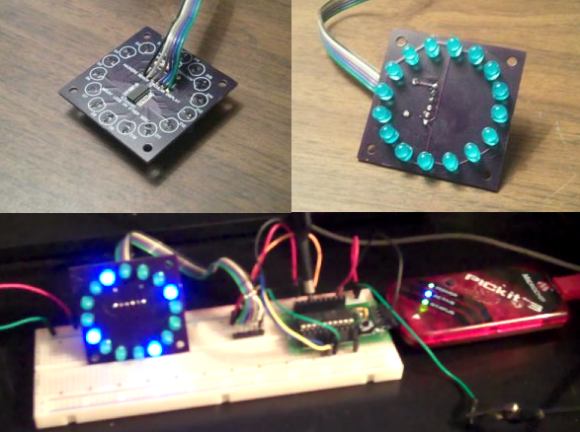
Sometimes, it’s the simple things that mesmerize. [JohnS_AZ] has created a simple dekatron style LED ring, but we can’t seem to stop watching his video. [John’s] LED ring began as a visual indicator for his Hackaday Prize entry, a water consumption display. Judging by his website, [John] is a bit of a display nut. Nixie tubes and huge clocks feature prominently.
We’ve seen plenty of LED projects using the trusty 74xx595 8-bit shift register. [John] personally isn’t a fan, as the entire chip is only rated to drive about 50mA. While hackers routinely push the chip several times past this limit, [John] found a chip designed for the task in the Texas Instruments TLC59282 16 channel constant current LED driver. (PDF link) While more expensive than the ‘595, the 59282 makes life much easier. Only one resistor is needed at the chip’s current sense pin, rather than a current-limiting resistor for each LED. The 59282 also provides a blank input, which is perfect for driving with PWM.
[John] designed a simple PCB with a the 59282 driving a ring of 16 LEDs. While he waited for the boards to come in, he wrote some test code for a Microchip PIC16F1509. [John’s] code is not optimized, but that makes it easy to see exactly which bit patterns he’s writing to the LEDs. It all makes for a great demo, and reminds us of those old Dekatron tubes.
It’s the demo video that makes this project. Click past the break and give it a watch. After several long days of judging entries, a really nice LED ring might be just what the doctor ordered.















Sweet!
The tlc5904 would enable you to PWM each led on its own. And you can daisy chain it to drive moar!! But for his application the TLC59282 works well. Although I see the 5904’s price now :D wow it’s expensive for what it does. Might have to change my design to use a lower cost part!
You can daisy chain multiple TLC59282’s as well. I’m considering using two of them in series for a VU meter application.
For a clock, perhaps bicolor leds. Tricolor with a second hand.
https://www.youtube.com/watch?v=qp-7i9uWu64&list=PLE83C70D980D9D924
For some reason my link points to another video – Sorry!
I might design it with a hole in the center so a pot or rotary encoder could extend through. Then the LEDs would surround the knob for either a pulsating effect or to provide feedback of the knob position.
“I might design it with a hole in the center so a pot or rotary encoder could extend through.”
Like that idea.
I designed this board specifically as an indicator, but I agree. If I respin it I will certainly include a center hole for a pot or shaft encoder. (among a few other changes I’d make)
If anyone else has ideas for rev2 of this board, I’d love to hear them.